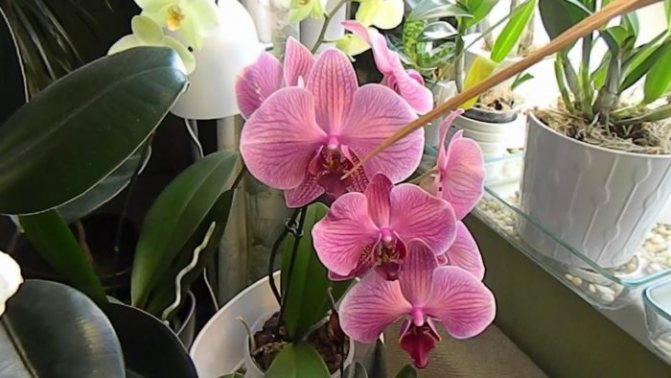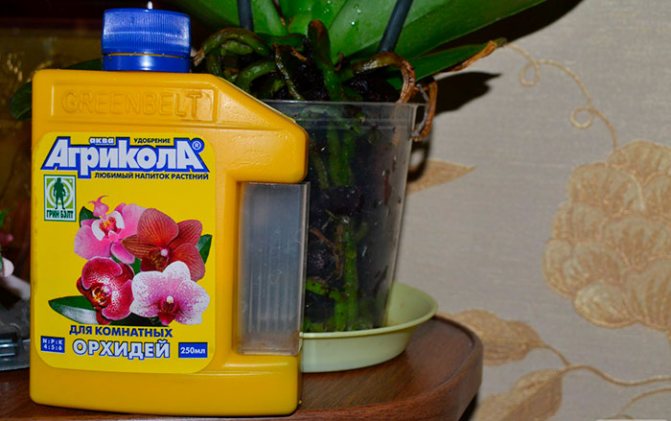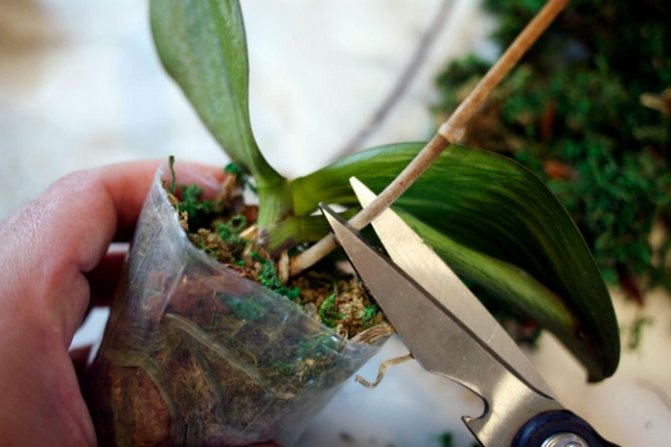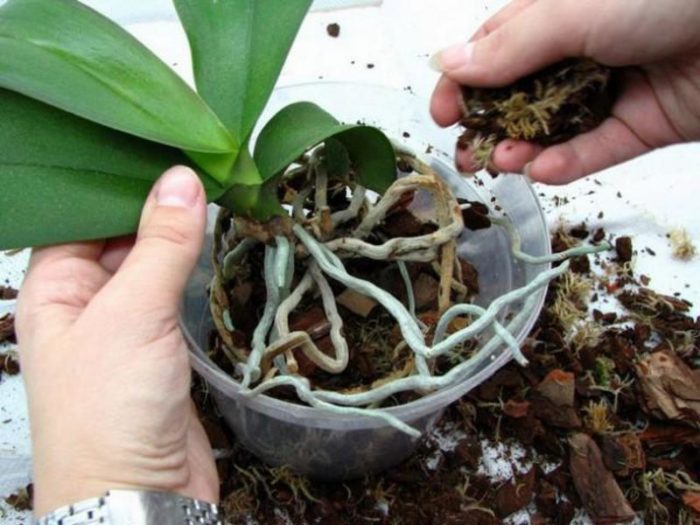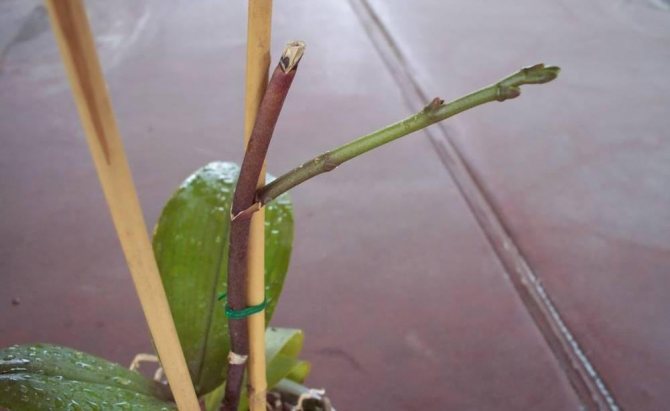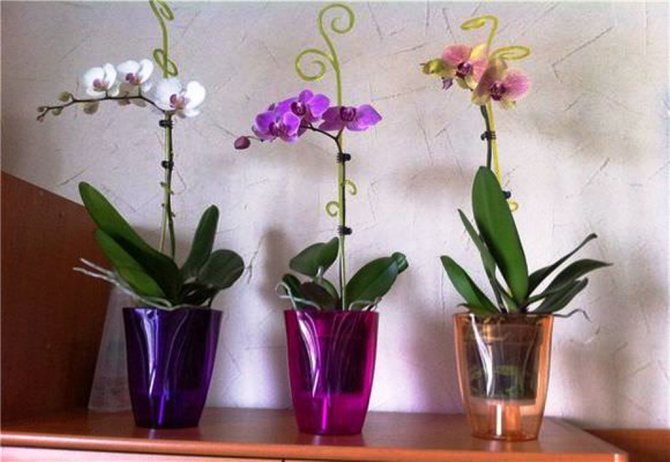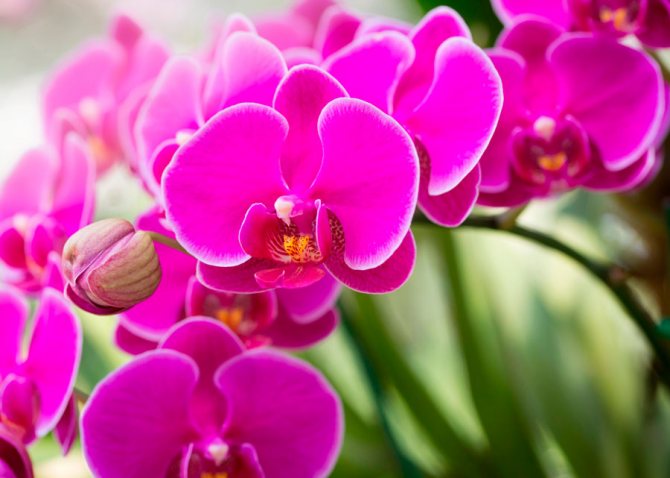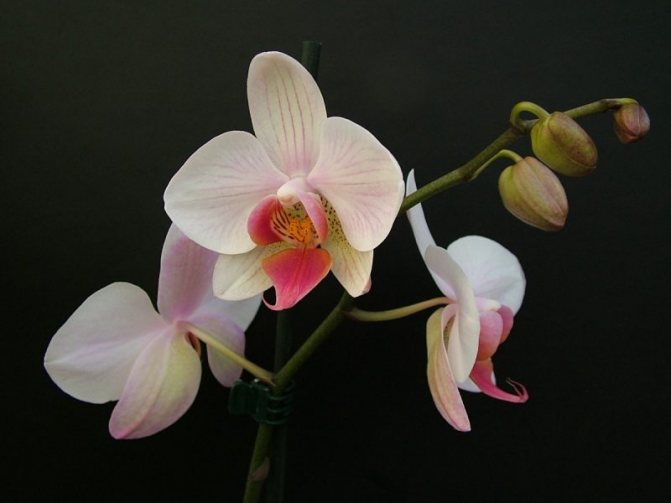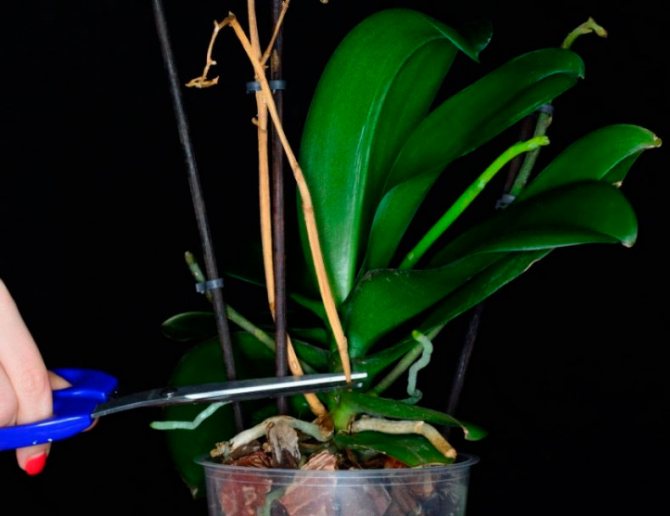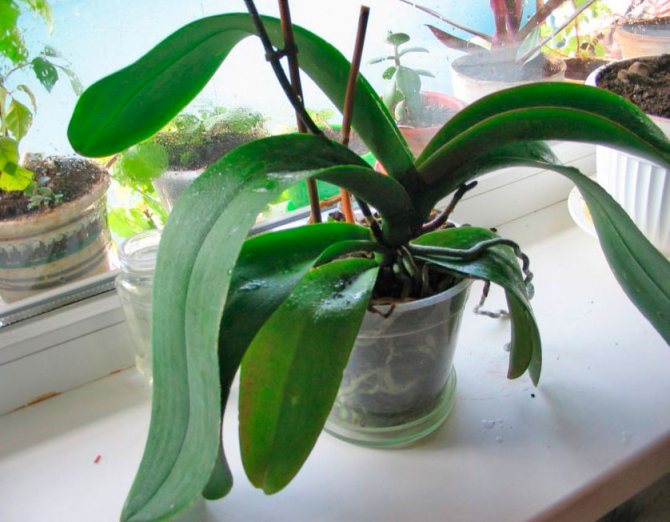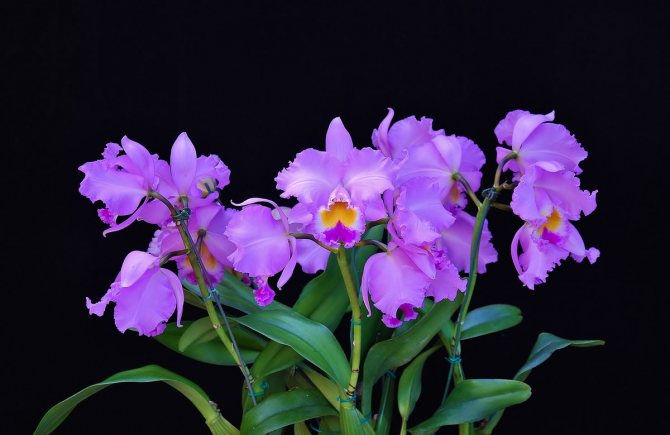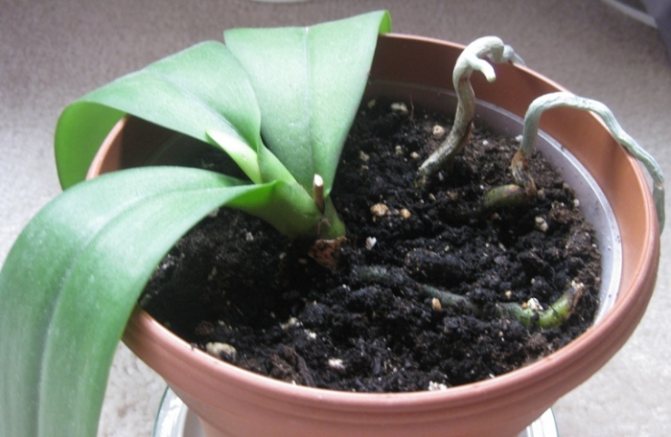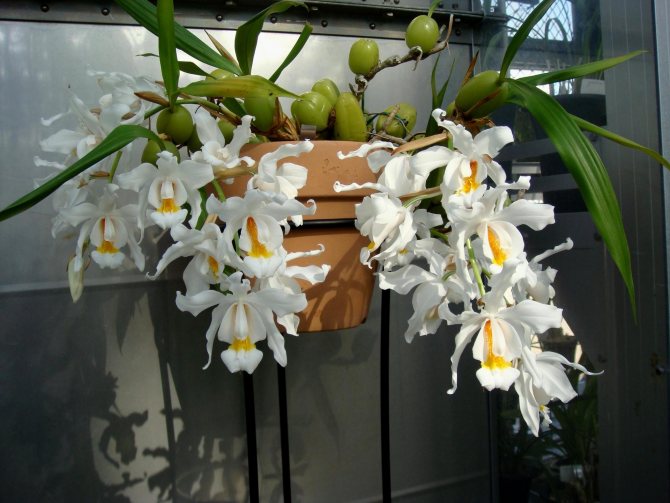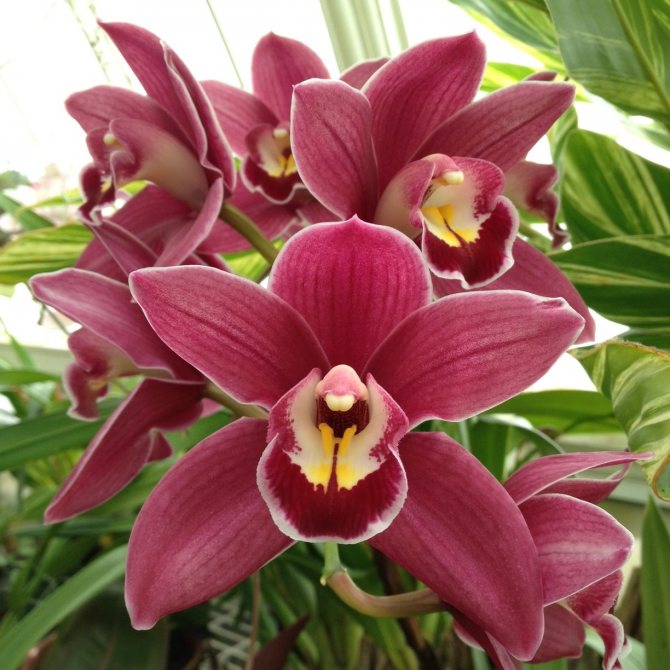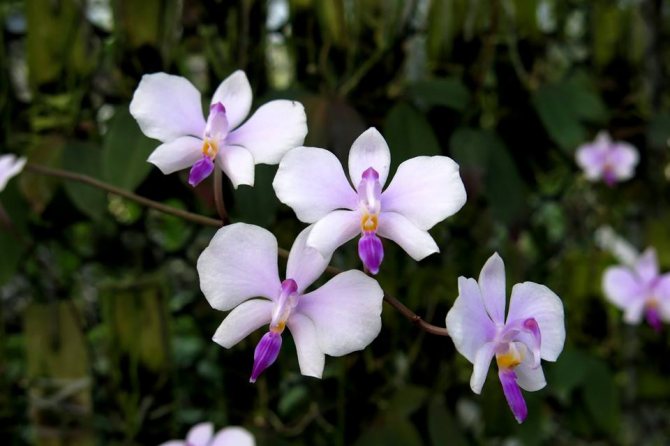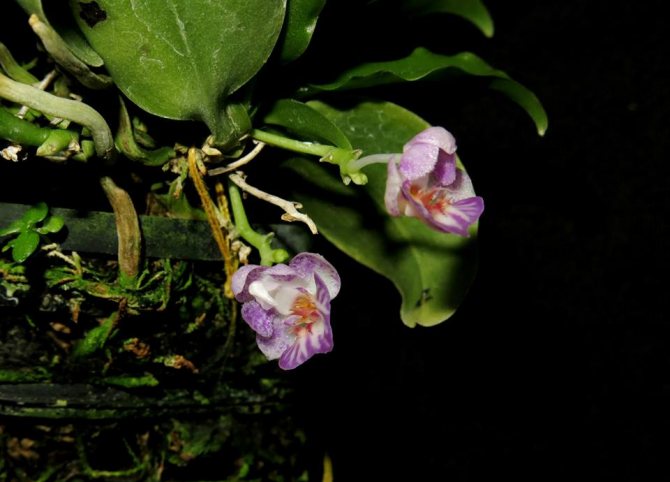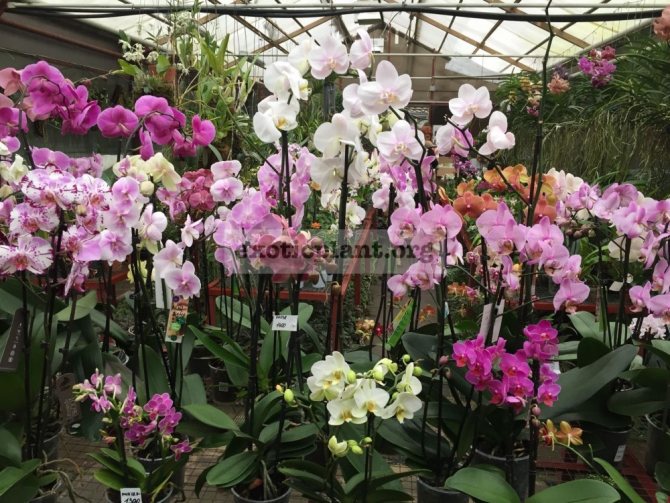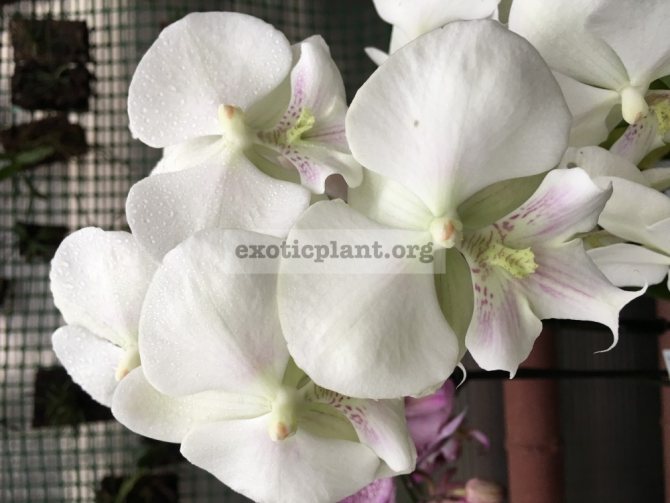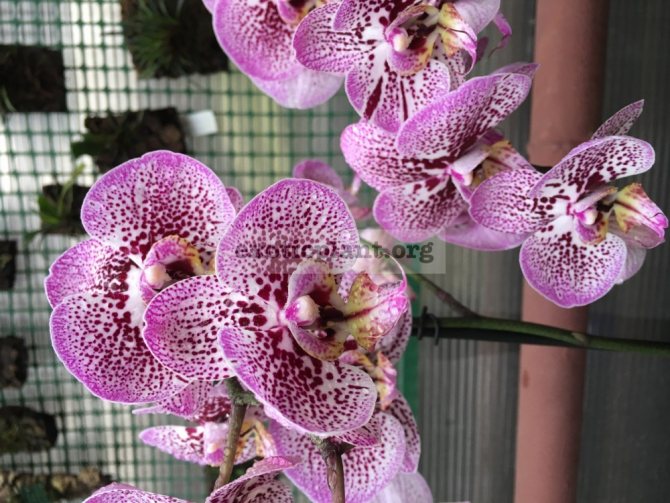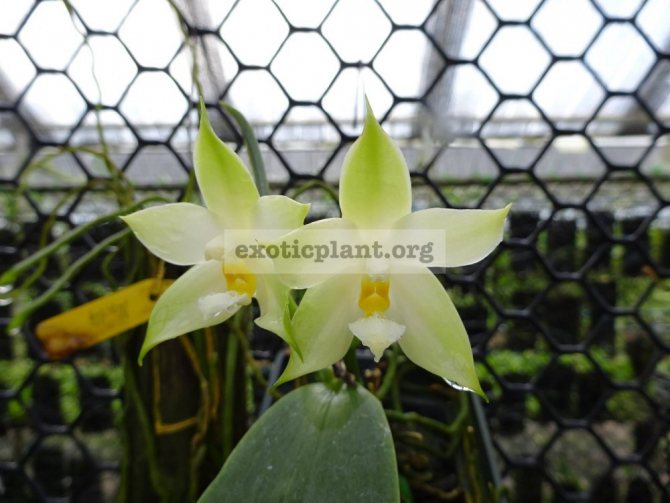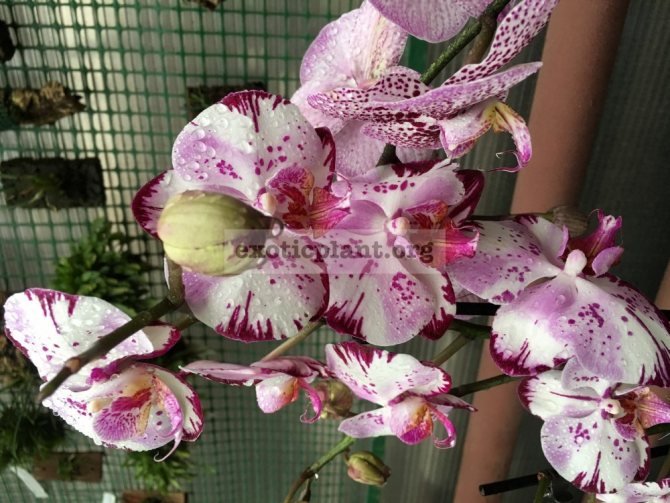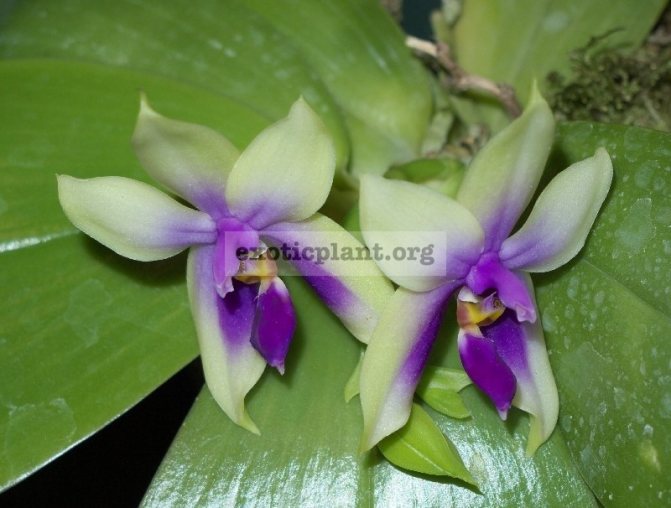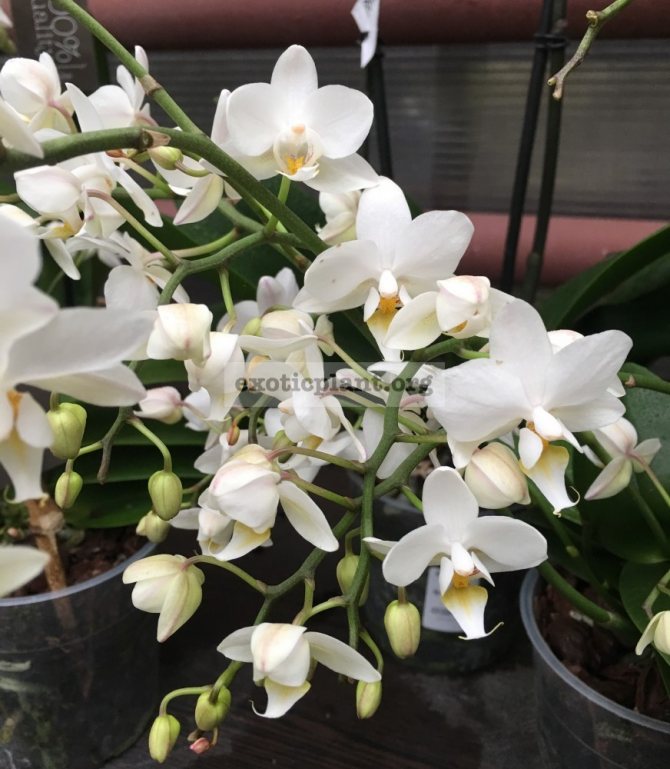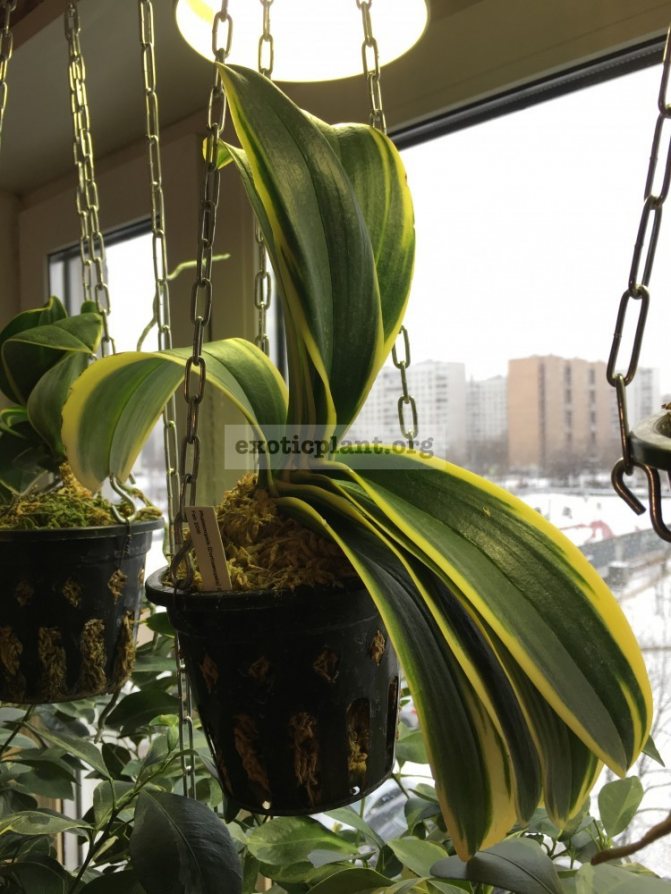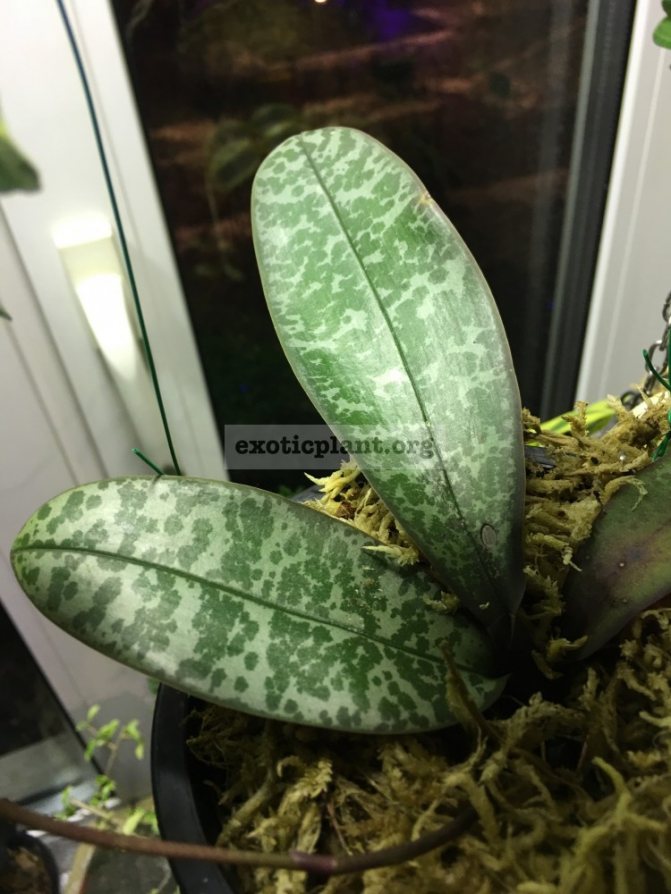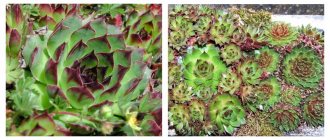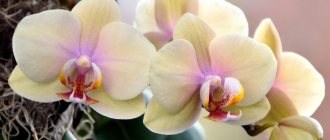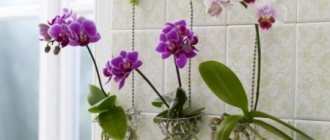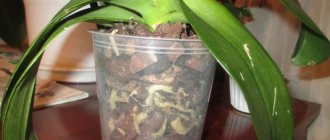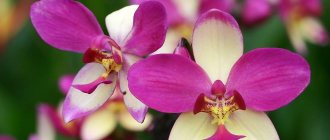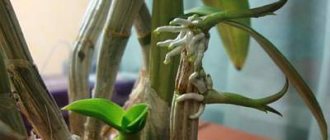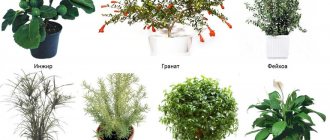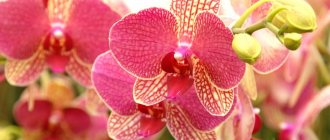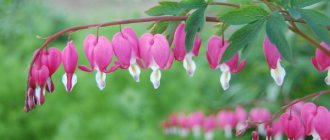- Views
- Phalaenopsis care
- Soil and transplant
- Reproduction
A genus of epiphytic plants, a bright representative of the Orchid family - Phalaenopsis. Phalaenopsis grows in southern Asia, the Philippines, partly in Australia, phalaenopsis prefers to grow in humid forests, leads an epiphytic lifestyle.
This windowsill potted orchid requires just as much attention as other houseplants, but no more.
In specialized literature, phalaenopsis is abbreviated as "Phal".
The genus contains relatively few species (about 60 species), however, there are many hybrid forms of the plant. Phalaenopsis is often called a butterfly orchid, the plant got this name due to its flowers, shaped like a butterfly. Like all plants of the orchid family, phalaenopsis is an ornamental flowering plant, which means it has colorful inflorescences. The petals are usually colored pink, white, and red. Some plants form large inflorescences of 150 flowers or more, but such inflorescences are rare at home. The leaves are thick, not long, do not grow abundantly and form a rosette, the color of the leaves is bright green, shiny. A long peduncle grows from the center of the rosette, usually one; aerial roots are also abundantly formed. The phalaenopsis root system is represented by a vertically shortened stem, it does not form a pseudobulb. Phalaenopsis blooms for a long time, the flowering time depends on the species, as a rule, flowering lasts about 2-5 months. In culture, about 20 species of phalaenopsis and many hybrid varieties are widespread. Phalaenopsis is widely grown in many countries, in Europe this plant has mostly ornamental value, in Asia phalaenopsis (like other orchids) is a cultivated plant, it can be found in homes, offices, various institutions, there are also phalaenopsis that can be grown on the street. in the botanical gardens you can always see the phalaenopsis. Photos clearly demonstrate the beauty of this plant.
Orchid description
The flower got its name because of its striking similarity during the flowering period with a flock of butterflies. Phalaenopsis (translated from Greek phalani - moth, opsis - likeness).
The orchid is distinguished by a monopodial growth form, that is, it has a single growth point.
A normal flower that grows without any pathologies has 4-6 fleshy shiny dark green leaves on the shoot at the same time. They grow alternately, with the upper ones being larger than the lower ones.
There are 4 standards:
- Mini orchids. The height of the plant together with the peduncle does not exceed 20 cm, the length of the leaf does not exceed 10 cm, the diameter of the flowers is 2-4 cm (examples: Hummingbird, Pink Girl and Philadelphia);
- Midi. It grows up to 40-55 cm, leaves up to 20 cm, flower diameter 4-7 cm (examples: Jena, Amabilis, Hieroglyphic);
- Normal. Reaches from 60 to 75 cm in height, leaves about 30 cm, flowers - 7-9 cm (examples: Stellenbosch and Cleopatra);
- Royal orchids - reach 80 cm, and some even one meter, leaves more than 30 cm, flowers - 12-15 cm in diameter (examples: Pirate Pikoti, Aphrodite, Cascade).
For compact flowers, choose a pot about 7-10 cm in diameter, for the rest - about 12-15 cm.
Flower shape
The flower vaguely resembles a butterfly.On long branched peduncles there are 3 sepals, called sepals, and 3 petals.
Two side petals (petals) are larger, wider and flatter, the third is located in the core, it has a smaller size and forms a "lip", a convenient platform for pollinating insects, on which nectar is collected.
This is interesting: the roots of orchids are covered with velamen - a whitish porous coating that protects the root system from drying out, with the help of which the flower absorbs moisture from the air. In addition, the roots contain chlorophyll, due to which, when exposed to light, they acquire a green tint.
Views
Use a stand to support the flower
In general, the species differ in size and color of the inflorescences; there are also species with more expressive features.
For example, Phalaenopsis mix has several (usually 2) peduncles, they are not much higher than usual. However, this species blooms slightly less than others, on the order of 1-2 months.
Phalaenopsis ambonese. This species is distinguished by a short stem, but the leaves, on the contrary, can reach a length of 30-40 centimeters, the flowers have a diameter of up to 6 centimeters. The flowers bloom slowly, one after another, so the flowering is quite long.
Phalaenopsis rider, also called mini phalaenopsis. The plant itself is not very small, the leaves can reach a length of up to 20 centimeters. But the flowers of the plant are small, with a diameter of only 1-2 centimeters, the flowers form rather dense inflorescences. Also, this species has a rich variety of colors.
Phalaenopsis Maria is one of the most interesting and rare species. This type of phalaenopsis differs in leaf color. In addition to white-pink tones, there are yakriye, pink and red spots on the petals.
Popular varieties
Of the huge number of varieties, we list the names of the most famous and original ones.
Black butterfly. A very beautiful and unusual phalaenopsis, the color of which, depending on the lighting, varies from a rich maroon with a chocolate tint to almost black.
There is no 100% black color due to the lack of corresponding pigment genes.
The petals have a pointed shape, the one located in the core (lip), white-yellow, with burgundy edging. On the peduncle there are up to 8 flowers, reaching 5 cm.
Diamond king. It has bright burgundy flowers with a light border (diameter - 8 cm). Petalia closer to the center is white, with small leopard blotches, similar to freckles.
Manhattan. Currently, this hybrid is not registered, it has only a trade name. The flowers are pale pink or pale lilac, strewn with many small point burgundy blotches, reminiscent of a marble pattern, with a bright orange or yellow core.
The peculiarity of the variety is that blotches can disappear with insufficient light.
Pavarotti. The variety is known for its dense, almost monochromatic flowers of a rich wine shade. The diameter of the flowers is up to 8 cm.
Valencia. A fairly rare variety of large phalaenopsis, growing up to 60 cm in height (including the peduncle). Sepals and petals are snow-white, lip is large, yellow on the inside and white on the outside. The center is deep burgundy with an orange rim. The flowering period is up to 8 months.
Kimono. The color of the flowers is speckled purple, with a whitish-yellow border. The veins and uvula are darker, burgundy, the center is yellow-crimson.They reach 7 cm in diameter.
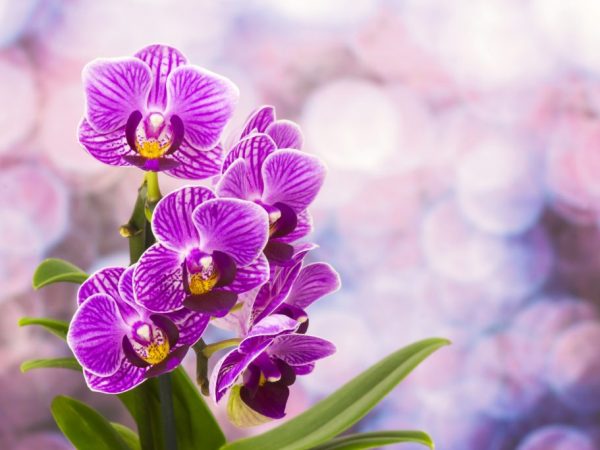
Phalaenopsis have a huge variety of varieties.
Legato. A hybrid with an unusual range of colors: on 2 peduncles, reaching a height of up to 60 cm, 2 times a year appear and bloom for more than 8 weeks flowers of pale pink, peach, golden-lilac pearlescent color.Closer to the center, there are dark specks on the silky petals. The core is bright orange.
The peculiarity of the hybrid is the fear of drafts and direct sunlight, it can die at temperatures above + 35 ° С.
Pelorica orchids should be considered separately.
Peloric is not an orchid variety; this is the name given to plants with irregular flower buds. Modification occurs as a result of mutation. Most often, petals grow together, as a result of which the bud does not fully open, sometimes different sepals or petals grow, taking the shape or shade of the lip.
The flower from monosymmetric (having 1 axis of symmetry) turns into radially symmetric, with several axes of symmetry.
Information: during hybridization, peloricity is permanent, ordinary flowers on the plant no longer appear.
Description of the plant and its types
Phalaenopsis is a genus of orchids, which includes about 70 species. All varieties are of the monopodial type. They grow with one trunk, side shoots are rarely formed on them.
Phalaenopsis is distinguished by large leathery leaves located sequentially on the trunk. The length of the leaf is up to 40 cm, however, some especially large species have leaves up to 1 m in length. The color of the leaves is dark green, but there are hybrid varieties with variegated leaf blades.
Orchids of this genus are epiphytes, they grow on the bark of trees, their root system does not go into the soil.
The roots of these plants are thick and devoid of root hairs. They are in the open air and have a green tint, photosynthesis processes take place in them. An overgrown specimen is distinguished by a large number of aerial roots that absorb moisture from the atmosphere.
During flowering, the orchid produces a long peduncle, on which many buds are located. The flowers open sequentially or simultaneously depending on the type of plant.
On one peduncle there can be up to several dozen flowers, similar in shape to butterflies. The color of the flowers is very diverse, they have white, pink, yellow, lilac shades, hybrid varieties are distinguished by variegated flowering.
Of the many species of this genus, the apartment contains only a few of the most unpretentious varieties:
- Phalaenopsis amabilis - a species characterized by long flowering. On its peduncle, up to 100 flowers can be located, which unfold sequentially and have a pleasant smell. Serves as a basis for creating hybrid forms;
- Phalaenopsis giant - a large species, the leaves of which are 60-100 cm long and up to 40 cm wide. It easily crosses with other species, therefore it is appreciated by orchid breeders;
- Phalaenopsis Luddemann - has an unusual shape and color of flowers, blooms in spring or early summer;
- Phalaenopsis Schiller - a plant characterized by long flowering. It blooms many times throughout the year. On the peduncle of an adult specimen, up to 200 buds are formed;
- Phalaenopsis Stewart - very decorative look with marbled leaves. Flowers bloom almost simultaneously, there can be up to 100 of them on the peduncle.
Natural species are quite demanding plants. Most often, various hybrid forms and varieties of phalaenopsis are grown in room culture. These flowers are very unpretentious, able to grow in living quarters and do not require special conditions for them. Phalaenopsis Orchid - photo of flowers:
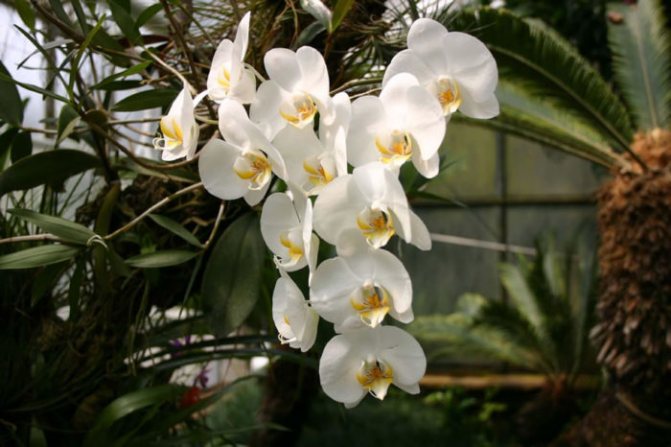

Amabilis
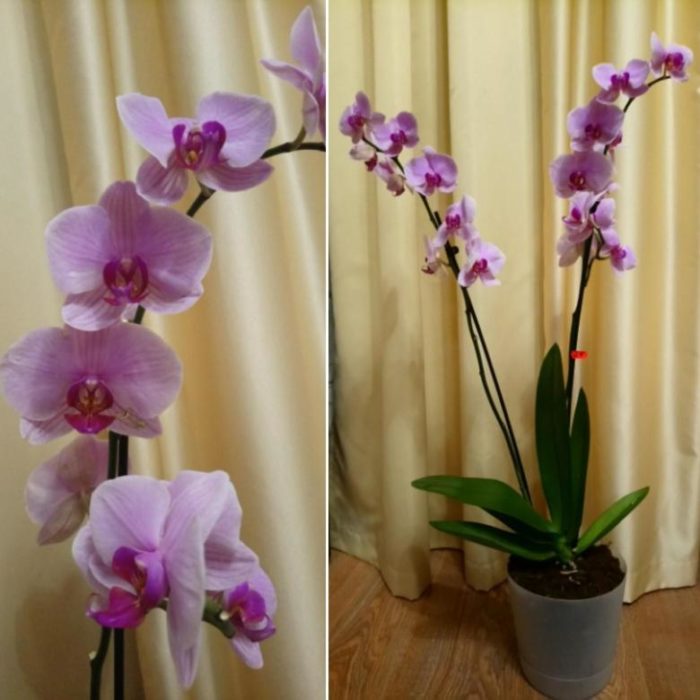

Giant
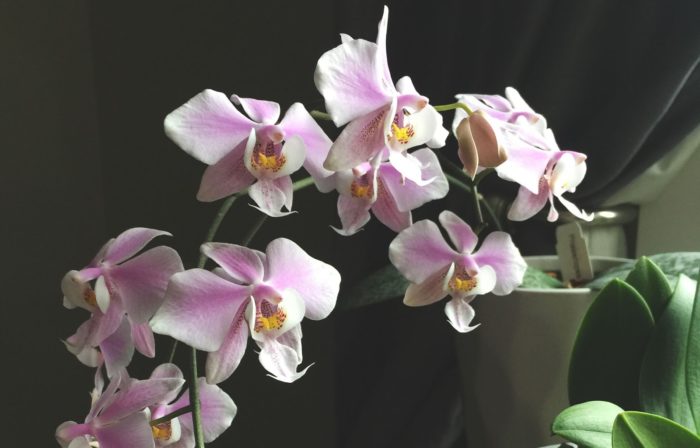

Schiller
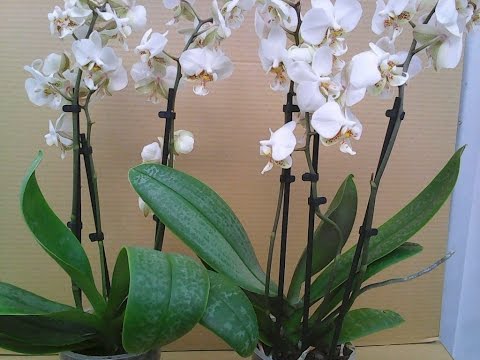

Flowering features
Phalaenopsis flowers begin to bloom at the age of 2.5 - 3 years.
Do not try to stimulate flowering before that. This negatively affects the plant.
It can be difficult to recognize the beginning of the process - adventitious roots can form on the stem, in addition to the peduncle. They can be distinguished by the following features:
- the peduncle has a pointed tip, scales appear in the embryonic stage.
- at the adventitious root, the tip is dull, the surface is smooth, without scales.
On some plants, buds appear almost simultaneously (this is most often found in pink species). In others (white species), the lower buds open first, then the upper ones, as a result of which the flowers on the orchid are present for a longer time.
With proper care, flowering can last up to 8 months.
Stimulating flowering
The more the daytime temperature differs from the nighttime, the faster the phalaenopsis bloom. In addition, flowering can be stimulated by a stressful situation:
- stop watering for 10 days;
- then immerse the pot in warm water for a quarter of an hour;
- after which they are fed.
Recommendations
The frequency and volume of fertilizing should be reduced.
At the initial stage, it is not recommended to rearrange the pot from place to place, to transplant.
If roots start to protrude from the drainage holes that look sick or damaged, or the soil has become dense and dries quickly after watering, you can transplant.
Pruning after flowering
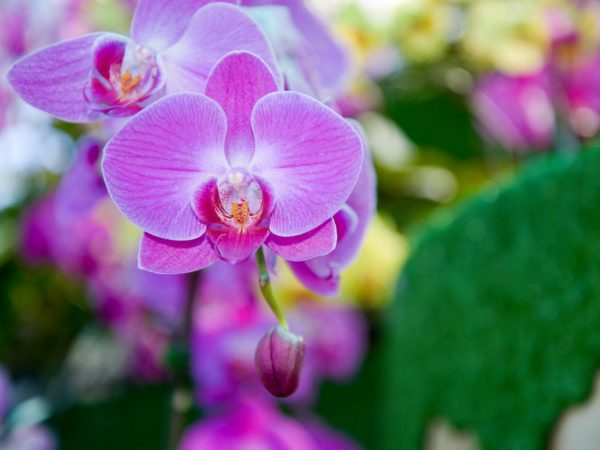

Only completely dried flower stalks need to be trimmed.
The peduncles of the plant dry up after flowering. They must be removed, and the place of the cut must be covered with wax, plasticine.
If only the top is dry, cut off only the dried part. Buds may still appear on it.
Attention! It happens that between the drying and falling of the first buds and the development of the second there is a certain pause. Therefore, do not remove the peduncle until you are sure that new buds will no longer develop on it.
Age determination
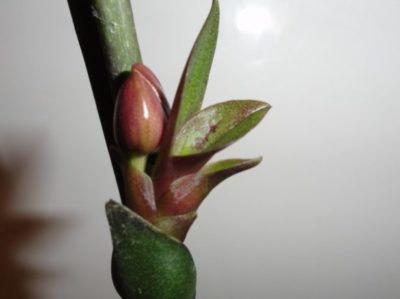

The age of the phalaenopsis is difficult to establish accurately. It is impossible to do this by counting the number of leaves.
It is known that a plant that has reached the age of five gives birth to children. Another way to set the age is to count the leaves and bulbs. But this is relative.
The owner must be sure that the plant is completely healthy and has never been transplanted.
Growing conditions
To grow a strong, healthy flower, it is important to observe a number of conditions.
Optimum temperature conditions:
- in the afternoon - from 20 to 25 ° C;
- at night - from 15 to 18 ° C.
When it rises to + 35 ° C and above or drops below + 12 ° C, there is a high risk of flower death.
Experts advise to provide phalaenopsis with a difference between day and night temperatures of 5-6 ° C, this will contribute to more active flowering.
Humidity
The culture loves well-humidified air. The most comfortable humidity is from 50 to 80%. It firmly tolerates its significant fluctuations, but with a decrease in the indicator to 30% or less, it begins to shed buds and flowers, and with an increase above 80%, the risk of fungal diseases increases.
If the level is insufficient, it is necessary:
- buy expanded clay, gravel, fill a wide pallet with them, moisten;
- place a pot with a plant on top so that the bottom does not come into contact with water.
It is advisable to periodically irrigate the leaves with warm, settled water.
Lighting
Phalaenopsis, although they like well-lit places, it is undesirable to place them in direct sunlight. The most favorable daylight hours are from 10 to 12 hours.
With a lack of light, especially in autumn and winter, the plant begins to shed flowers and buds.
A way out of the situation can be additional illumination with phytolamps, which do not make the air dry and do not overheat it.
The best place in an apartment for growing orchids is the windows facing east or west. On the south - they need to be shaded.
Useful video
Secrets to care immediately after buying an orchid I bought a new orchid, what should I do? - video
Orchid: where is its main place in the house? - video
Phalaenopsis is a fragile and delicate, rather unpretentious flower. The orchid has taken its rightful place in the collections of thousands of flower growers.Many are so carried away by the cultivation of this plant that they are constantly acquiring copies of new varieties. And this is not surprising. Phalaenopsis bloom can last up to six months without interruption, and then begin again after a short time. To do this, the owner of a butterfly orchid should only show a minimum of care.
Landing rules
In addition to observing the growing conditions, it is equally important to observe the timing and technology of planting butterfly orchids, to choose the right soil, capacity.
Priming
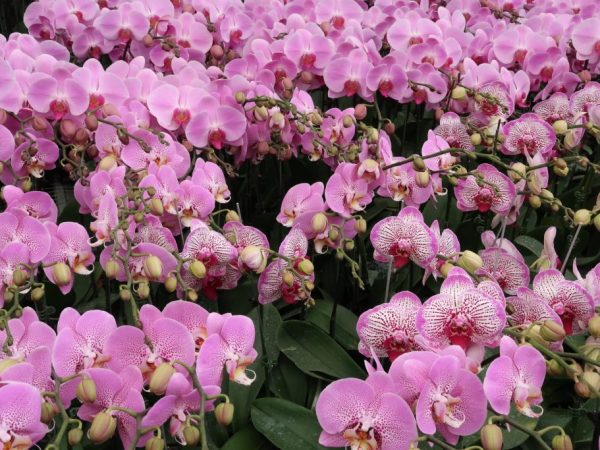

Flowers cannot be planted in ordinary soil.
In the wild, phalaenopsis grow on trees; they cannot be planted in ordinary soil.
You can buy a special soil for orchids in the store, which most often includes crushed bark and moss, or you can prepare the substrate yourself.
It is desirable to include in it:
- a large fraction of the bark of dry coniferous trees (for example, pine);
- peat moss (sphagnum);
- charcoal.
The bark should be free of resin and mold; before use, it must be boiled for about 3-4 hours.
It is best to take birch charcoal, after grinding it to pieces of about 2 cm in size. In the substrate, its amount should be about 5% of the total mass. Make sure that the soil used is loose, lightweight.
Capacity
Orchid roots, like leaves, carry out photosynthesis, so it is advisable to choose transparent pots for them with drainage holes. This will allow the plants to receive the required amount of sunlight, and the owner of the flower to control the need for the next watering.
An ideal option would be a container with a special step at the bottom, from 3 to 4 cm in height, on which the plant is planted. At the same time, the roots hang freely. At the bottom, to improve aeration, drainage is poured in a layer of 2-3 cm. It can be pieces of foam, cork, coconut fiber, expanded clay.
Tip: For the flowering period, place the orchid pot in an opaque planter. This will have a beneficial effect on her condition.
Timing and technology
It is best to buy an orchid in the store in the spring. At this time of year, her flowering ends and the growing season begins.
If the c of the branches looks healthy, it does not have dried or rotted leaves, damaged, diseased roots, there is no need to transplant it immediately, creating an unnecessary stressful situation for the plant.
The procedure is carried out only in the presence of the above disadvantages, too small a pot size, excessive soil compaction, etc.
Before planting, do not water the orchid for several days for better extraction from the container.
Standard landing technology:
- remove dead, dried roots, rotted leaves on the plant (yellowed leaves should not be removed, since they still contain a certain composition of nutrients, they can be removed later, after complete drying);
- powder the cut with charcoal;
- put drainage material on the bottom of the pot with a layer of about 5 cm;
- on top, pour the substrate prepared by yourself or bought in a specialized store in the same layer;
- place a flower in the center of the pot, placing a piece of foam or coconut fiber under the outlet (try not to bury the root collar in the ground);
- sprinkle the roots with the substrate, lightly press down;
- immerse the orchid in water for a short time;
- in case the soil is a donkey - add the substrate.
To maintain the flower stalk during the flowering period, you can stick a support of a suitable size into the pot.
Pruning and watering
When all the flowers are withered, cut the peduncle with pruning shears just above the base so as not to damage the leaves. The rest of the peduncle will subsequently dry out and will be easy to remove.
Remove yellowed leaves before watering to prevent decay of the plant. To do this, cut them longitudinally in two and pull out carefully, holding the plant with your other hand so as not to accidentally pull it out of the pot.
Keep the substrate moist at all times. Check the moisture with your finger, dipping it into the substrate 1-2 cm. Water the plant regularly with soft water, preferably in the morning. Make sure that no water gets on flowers, young shoots and leaves. Paphiopedilum is very susceptible to the decay process.
Care
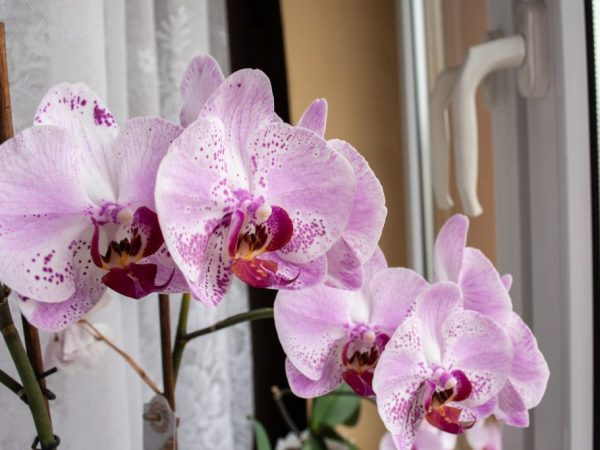

Phalaenopsis are watered with warm water
For a good adaptation of the plant after planting, it is necessary to properly care for it: water, feed, cut, stimulate the flowering process.
Watering
Phalaenopsis are watered with moderately warm, settled or filtered water, the temperature of which is 2-3 ° C higher than room temperature.
Watering is desirable in the first half of the day, 1-2 times a week. In dry climates, it should be more regular.
Methods:
- immersion in water for 15-30 minutes;
- spilling under a shower stream for 15-20 minutes;
- watering from above.
The flowers are watered abundantly, but at the same time they carefully monitor that the substrate has time to dry completely before this, the roots have a silvery tint. Waterlogging can lead to decay, and a lack of moisture can lead to inhibition of the growth of shoots and roots, lethargy of leaves, and thinning of the roots.
Recommendation: if after 1 hour there is still water in the sinuses of the leaves, blot it with a dry napkin.
Top dressing
Orchids cannot be fertilized:
- within 2 months after purchase;
- during flowering, as this can accelerate the flowering of phalaenopsis;
- within a month after transplanting, when the flower is under stress.
Orchids are fertilized in a state of active growth, when roots and leaves grow, new buds are formed.
It is not recommended to feed phalaenopsis with organic fertilizers, as there is a high risk of getting burned by roots and leaves.
It is better to use special complexes "for orchids": Agricola, Bona Forte, Kemira-Lux, Uniflor-bud, Uniflor-growth, Greenworld, Pocon, etc. Plants react very well to succinic acid.
Fertilization frequency:
- in the summer - 2 times a month;
- in winter - once a month.
Important! Before fertilizing the flowers, be sure to water them well to keep the roots moist. If fertilizer spills onto dry roots, it can burn them.
Fertilizer and transplant
During the year, except for the period between the flowering of the plant and the appearance of new shoots, add special fertilizer during watering once - from spring to autumn and twice - in winter.
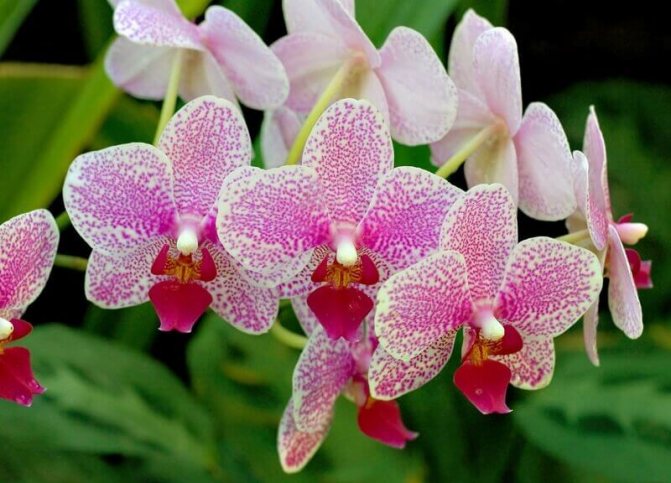

To stimulate secondary flowering, add special fertilizer for flowering orchids from the end of the growth period until the new leaves emerge after flowering.
Phalaenopsis does not need a regular transplant. Only if the roots have filled the entire pot and signs of decay are visible, in spring or summer, after flowering, carefully remove the plant from the pot. Free the roots of any residual substrate.
Do not prune aerial roots, even if you think they are dry. In fact, they function normally. Remove dry or rotten roots with a sharp, disinfected pruner. Cut them as close to the base as possible. After this operation, disinfect the secateurs again.
The substrate for phalaenopsis should consist of 80% medium-sized pine bark and 20% medium-sized expanded clay. You can add a little sphagnum to increase the moisture content of the substrate, but in this case, be careful not to over-water. Moisten the mixture before use.
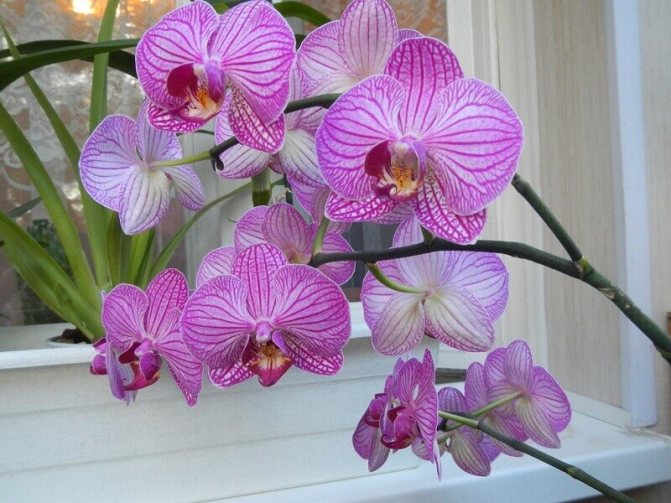

Take a pot slightly larger than the previous one and fill it with a damp mixture (see tip above). The level of the backfilled substrate should be 2 cm below the edge of the pot. Place the plant in the center. Add the substrate so that the base of the plant - the neck - remains above its level. Tamp the mixture with a stick from time to time.Do not water the orchid until new shoots appear (after 2-3 weeks). It is enough to spray the surface of the substrate with soft water at room temperature (avoid getting water into the core of the plant).
Care after purchase
Phalaenopsis purchased in the store needs to create comfortable conditions for normal adaptation and getting used to a new location:
- for several days the flower is not watered (with the exception of plants planted in too dense or overdried soil, which can be watered with warm boiled water);
- Phalaenopsis is not sprayed or fed for 10 days;
- for a week, they are provided with an arrangement on a window with diffused sunlight, then put in a permanent place.
If Phalaenopsis is evenly located in the container, stable, the substrate meets the recommended standards, the root system and leaves look healthy, then it is permissible to leave the flower in a store pot for a long period (up to 2-3 years).
How to choose Phalaenopsis in the store
In order for the orchid to quickly adapt to the new conditions of the apartment and feel comfortable, when buying a plant, you should take into account some of the nuances:
- It is possible to determine the color of a future pet only in a blossoming state. In addition, the blossoming buds without disturbing the juiciness of color, firmly seated on a peduncle, will show a healthy plant. - Buy an orchid during flowering.
- A diseased plant will be betrayed by its root system: if the roots are sluggish, with spots of rot, and the orchid vibrates in the pot when touched, then you should not buy it (the flower is weakened). - When buying, check the health of the roots.
- A healthy orchid will certainly powerful, fleshy leaves... They should be free of cracks, scratches and dry areas. Most varieties have dark greens. - When buying an orchid, pay attention to the leaves.
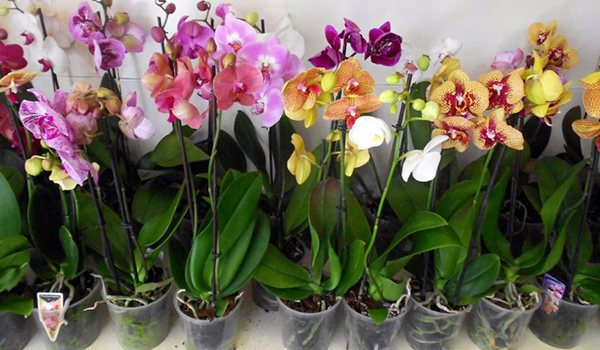

Diseases and pests
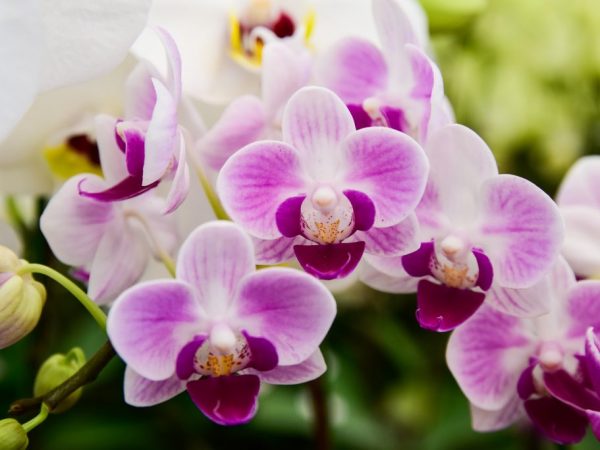

With proper care, the plant rarely gets sick.
Most often, the defeat of various diseases and fungi occurs due to errors in the watering procedure and the temperature of the content that is not suitable for the plant.
Brown spotting. Signs: yellow or dark spots, streaks, streaks on the leaves, sticky bloom, leaf lethargy. The affected leaves are removed, the cut site is treated with iodine.
Powdery mildew. White bloom on leaves and buds. The flower is watered, after 2-3 hours it is sprayed with the fungicidal preparation Skor, colloidal sulfur. For prophylaxis, Phytophtorin is used.
Rot (symptoms - fleecy, spots and dots). Views:
- Gray. Treatment: treatment with Immunocytophyte. Prevention: the use of bioimmunostimulants.
- Brown. Treatment: treatment with colloidal sulfur, fungicides. Prevention: spraying the plant with a solution of copper sulfate.
- Black. Treatment: diseased parts are cut off, the cut site is impregnated with colloidal sulfur.
- Fusarion (grayish shade of leaves, pink bloom, flabbiness). Treatment: three times a day for 2 weeks, the container with the plant is completely immersed in a 3% Fundazole solution.
Anthracnose. Signs: small, growing black spots that eat away the leaves. Damaged areas are removed to healthy tissue. The wound is sprinkled with ash, smeared with iodine. Severe lesions are treated with fungicides Skor, Ridomil in 3-4 approaches with intervals of 10 days. Prevention: treatment with Mikosan.
Rust. At first, the lower part of the leaves is covered with light spots. Gradually, the entire leaf twitches with a rusty bloom. Treatment: removal of affected leaves, treatment of cut sites with activated carbon. With small lesions - spraying with a 20% alcohol solution, with significant ones - using fungicides.
The most common pests on the plant are:
- spider mite;
- shield;
- mealybug;
- aphid;
- thrips.
To get rid of pests, a pot with a plant is immersed in water for 15 minutes, the affected areas are wiped with a water-soap solution, treated with insecticides, acaricidal preparations.
It is necessary to remove dried stalks, leaves, damaged roots in time.
Location and support
Phalaenopsis needs a high, but not excessive level of substrate moisture, so its roots, with a lack of moisture, go outside the pot to absorb water from the air. Place the container with the plant on a pallet of damp expanded clay. Place a grate between the pot and the expanded clay so that the drainage holes are not clogged.
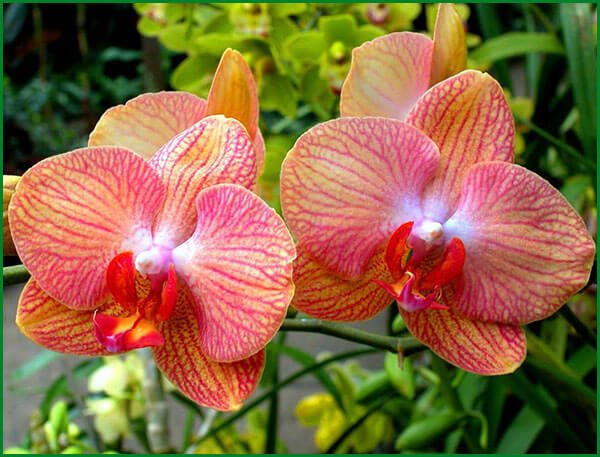

Transparent containers are suitable for phalaenopsis. They are convenient because it is easy to check the condition of the roots in them; if they suddenly begin to rot with excess moisture or shrinkage of the substrate. If you notice damage, the plant needs to be repotted.
The planter should be selected in such a way that its diameter is two fingers wider than the pot, and the height should be 5-6 cm more. In this case, the edges of the pot and the planter should match, so take a soft mesh, roll it up and place it under the pot to raise it a little.
In order for the container with the plant to become more stable, a support will be needed for the peduncle. Bury the support in the substrate in the immediate vicinity of the peduncle, without damaging the roots. Attach the support to the peduncle in two places with clips. The support should be installed before the buds open, as the flowers will wilt faster if you change their position after the bud.
Reproduction methods
- Vegetative. If the adult phalaenopsis is well developed, you can cut off its top and plant it in a loose substrate for rooting. A baby can also appear from a dormant bud at the base of the peduncle. They are waiting for her roots to grow about 5 cm, then they are separated and planted in a transparent container. Do the same with the lateral processes.
- Growing from seeds. It is best to use seeds from a green pod, removed about a month before its normal opening, that is, 4-4.5 months after pollination. They quickly lose their germination; they can be extended for a short time when stored in the refrigerator. The planted seedlings will be ready to be transplanted from flasks into shared pots in about six months. After transplanting, they are covered with glass to achieve a greenhouse effect. When the seedlings are old enough and strong enough, they are transplanted into pots with a diameter of 10 cm.
At home, vegetative propagation is usually used due to the complexity of the procedure for growing from seeds.
How many years does an orchid live?
The lifespan of each individual flower is individual and depends on many factors. In addition to temperature, humidity and light, the longevity of orchids is influenced by:
- belonging to a specific variety and species;
- timing and mechanism of transplantation;
- watering and feeding regime;
- composition and quality of the substrate;
- the presence of diseases and pests.
All flowers of the orchid family are divided into monopodial and sympodial. Monopodial branching means the presence of a single stem emerging from one point of growth and gradually growing leaves at the top. Moisture and nutrients accumulate in the fleshy leaves and thick stems. They rarely give fresh shoots, and therefore aging and dying occurs earlier in them.
Important! Monopodial plants do not produce seeds at home; they can reproduce only vegetatively.
Sympodial plants have a different number of shoots connected by a rhizome. They constantly have new shoots and pseudobulbs are formed - thickenings on the stems in which nutrients and moisture are accumulated. They are updated more often, and therefore live longer.
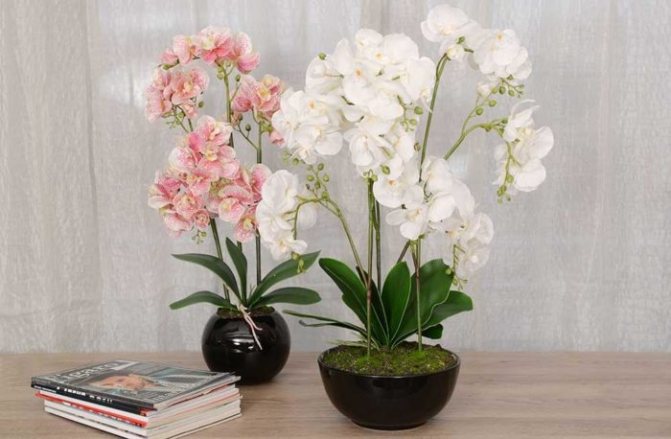

In nature
In their natural environment, orchids live many times longer than their domestic relatives. This is due to the fact that the plant is able to independently control the composition and volume of nutrients required for normal growth. The lifespan of a wild flower can be about a hundred years.
Interesting! Scientists are aware of individual cases of orchids reaching two hundred years of age.
Premature death of a flower living in nature occurs only under the influence of external negative factors:
- falling a tree, crushing or moving a stone that serves as a support for a flower;
- a sharp onset of cold weather or drought;
- various diseases;
- pest attack.
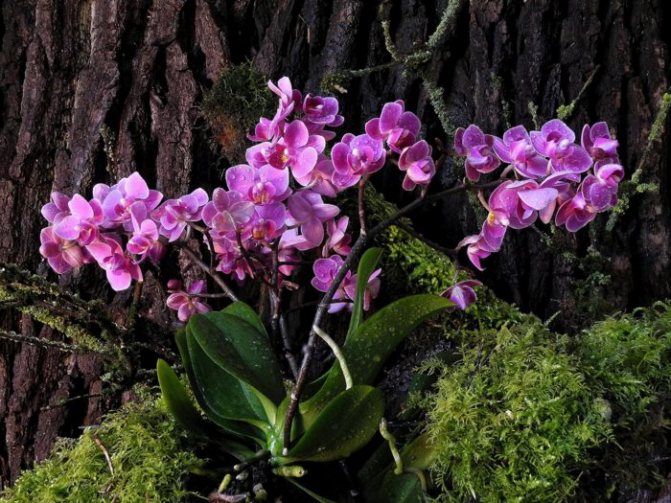

At home
The life span of an indoor orchid with proper care is on average 5–7 years. There are cases when they lived to be 20 years old.
Modern orchids are the product of selection aimed at improving the appearance of the bud. It is impossible to determine, as a result of crossing of which varieties, these or those flowers appeared, which means that the duration of their life cannot be predicted.
But you can say for sure what factors can cause their death:
- Non-compliance with the temperature regime and the presence of drafts. Different varieties of orchids require different temperatures, but none of them tolerate drafts, especially in the cold season.
- Sunburn. In nature, orchid plants prefer to settle in shady places, avoiding the open sun. At home, it is recommended to fulfill the same requirements.
- Dry air. Orchids, which take moisture from the atmosphere, do not tolerate the dryness of rooms in city apartments.
- Excessive watering. Too much water in the pot leads to root rot, mold and algae.
- Lack or excess of fertilizer. Many types of orchids need feeding, but the amount of nutrients must be strictly dosed.
- Late or wrong transplant. With an inept transplant, roots or foliage can be injured.
- Wrong ground. Orchids are planted in a special substrate with a special composition and texture.
- Diseases and parasites. It is necessary to take timely measures to eliminate painful conditions or get rid of pests.
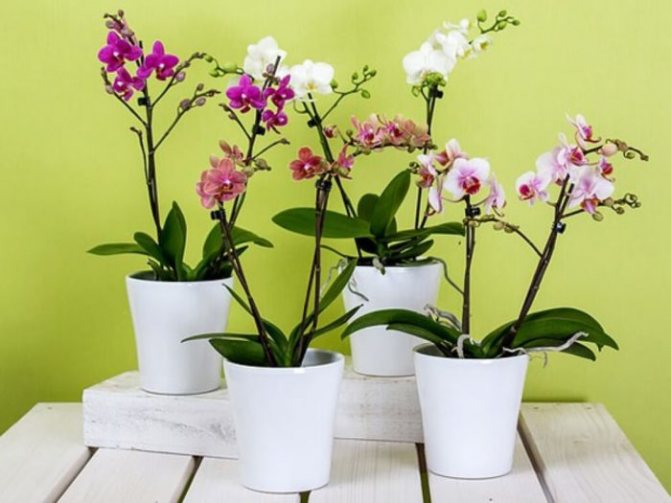

The value of varieties
There are two main types of window sill indoor orchids: sympodial and monopodial. Although the aging processes of both varieties are irreversible, the extinction of these plants occurs at different rates.
Monopodial cultures are not characterized by rapid reproduction, children are formed extremely rarely. When growing orchids of this type, difficulties arise and it is far from always possible to prolong the presence of an indoor flower in a room with the help of an old plant.
On the other hand, sympodial varieties develop very well. Thanks to the accelerated formation of pseudobulbs, the grower has the opportunity to constantly update the plant interior design.
Unfortunately, the first group includes the most beautiful indoor orchid - phalaenopsis. How long does an orchid live that is not capable of the rapid continuation of its kind? If you make every effort and provide her with proper care, she can still reward her owner with several childbearing formations. In this case, the plant can last from 5 to 7 years.
The flowering period is more influenced by what varietal features the hybrid parents awarded the orchid. Usually in phalaenopsis it lasts about three months twice a year, with the best care it can be increased to 8-9 months.
Orchids such as dendrobium and papiopedilum live no more than 5 years. However, with timely transplants, they can last longer. The most venerable long-liver is considered to be a variety of kattea. Meanwhile, some gardeners have observed cases when the life cycle of these varieties lasted 18-20 years.
Currently, due to the large number of varieties, it is not always known which varieties were used to breed new hybrids. Therefore, the exterior appearance of plants and how long orchids live are still more influenced by good care.
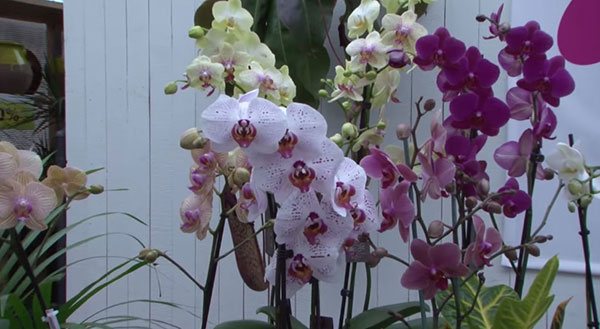

The main problems when growing a plant
The leaves will tell about the health of the flower. If the leaves turn yellow, it means that you are not providing proper flower care.There are a number of factors that can lead to discoloration of orchid leaves, including direct sunlight, cold temperatures, and root rot.


Here are the instructions for eliminating yellow leaves on Phalaenopsis orchids:
- Phalaenopsis orchid leaves may dry out and turn yellow if exposed to direct sunlight. Shade or place the orchid in a place with enough light;
- too low temperature. Make sure the temperature is between 18-26 degrees during the day and 15-21 at night;
- excessive moisture leads to root rot, which in turn can cause the leaves to turn yellow. To avoid this, water the plant only when the topsoil is dry and the roots are white, and make sure there are enough holes in the pot to ensure proper drainage.
If your orchid is suffering from root rot but you can see that the plant still has healthy green roots, trim off the decayed parts and transplant it into a new environment.
What is an orchid?
Under "orchid»It is customary to understand, in principle, any flower belonging to the orchid family, which is one of the most ancient plants in terms of evolution. Within the orchid family, scientists distinguish 5 plant subfamilies, 22 tribes, and 70 subtribes. The peculiarity of the orchid family is the huge variety of flower species. There are about 75 thousand of them in total.
What is Phalaenopsis?
Phalaenopsis Is a genus of plants belonging to the orchid family. The main habitat of these flowers is Southeast Asia, Australia. Natural Phalaenopsis loves moist forests - both in the plains and in the mountains.
What factors affect life expectancy?
There are factors that affect the lifespan of an orchid. Knowing them, it is easy to achieve that she will decorate the windowsill for 10-20 years.
Variety and type
Breeders bred hybrids by crossing different varieties. Each of these varieties can have 20-40 progenitors. Having done this, they themselves cannot answer the question: how long will the orchid live. Most often, the whole time of life depends on how the hostess will look after her. In one, the hybrid Phalaenopsis will die 3 years after purchase, while in the other it will live five times longer.
Rest phase
After the end of flowering, the plant has a resting time. As soon as all the wilted flowers fall away, it is recommended to move the pot to a cool place, reduce the number of watering by 3 times. It is not recommended to apply fertilizers during this period. If the peduncle dries up during the rest period, it will need to be removed. In some Orchid species, the stalks remain green. In this case, they can be left as they are, or they can be trimmed to the first bud, or completely removed. A dormant period is necessary for the plant to gain strength before the new vegetative period.
What is the difference between an orchid and a phalaenopsis?
Orchid is a family of flowers, and the phalaenopsis comes from this family. This is precisely the main difference for them.
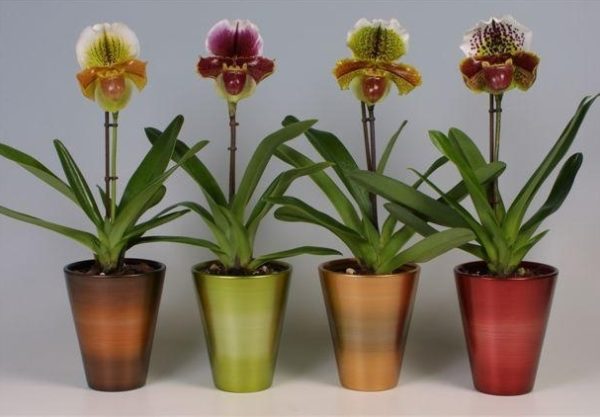

There can be no visible differences between orchids and phalaenopsis, since phalaenopsis is a genus of the orchid family.
The minor differences are:
- Different number of species;
- Distribution area.
From the point of view of biology, the genus all structural features of the orchid family are inherent, in this they are absolutely identical.
The main similarities of plants
Since all orchids belong to the same family, they have some similarities. These include:
- Inflorescence type. All plants of the family have flowers collected in the form of a brush or an ear.
- The flowers have one petal that stands out from the others - the lip.
- Pollinated exclusively by insects.
- Numerous seeds, collected in a box, or berries.
- Seeds germinate only with the formation of mycorrhiza.
Interesting! These signs unite all types of orchids with very rare exceptions. For example, the famous lady's slipper is also an orchid, but it has single flowers that are not collected in inflorescences.
In general, it is not difficult to distinguish orchids from other plants.
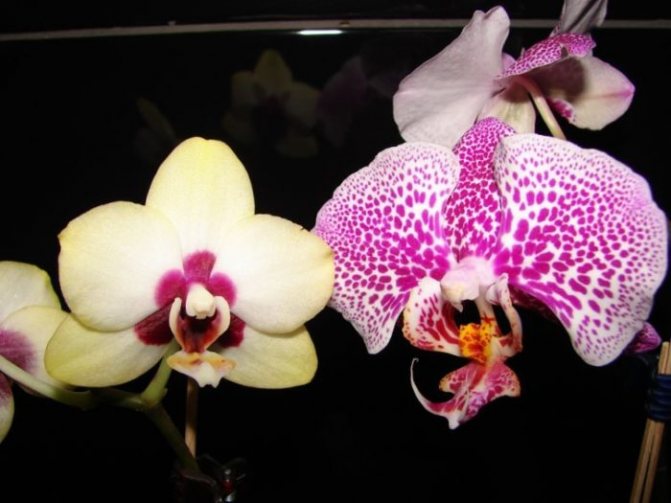

5 / 5 ( 1 vote)
Step-by-step instructions on how to rejuvenate an old plant
The way to rejuvenate the Phalaenopsis orchid is simple. You don't have to take it out of the pot to do this. We will tell you how to update an old orchid.
- Preparing the trimming tool.It is best to use a garden pruner rather than a sharp-edged pair of scissors. Before the procedure, the instrument is treated using an alcohol solution.
Pruning. Taking a pruner in hand, cut off the top with aerial roots, moving from the bottom of the stem. The lower part and part of the stem are left in the old pot. Over time, children will move away from the hemp at the roots.
If the roots stick up and do not fit in the pot, soak them in water. After this procedure, they will become more elastic and put them in the pot as they should. If leaves interfere with this, cut them off, exposing the neck.
Watch a video on how to rejuvenate the Phalaenopsis orchid:
Comparison
The main difference between an orchid and a phalaenopsis is that the first name corresponds to a family of flowers, the second to a separate genus, which at the same time is part of this family. Orchids are represented by more than 75 thousand types of flowers. The genus Phalaenopsis includes about 40 species.
Orchids as a family are found on all continents of the Earth, except for Antarctica. Phalaenopsis naturally grows mainly in Southeast Asia and Australia.
At the same time, all those features that characterize orchids from the point of view of biology are characteristic of phalaenopsis. In particular, the presence of accrete stamens, as well as the inability of pollen to spread through the air.
Having determined what the difference between an orchid and a phalaenopsis is, in principle, we reflect the conclusions in the table.

